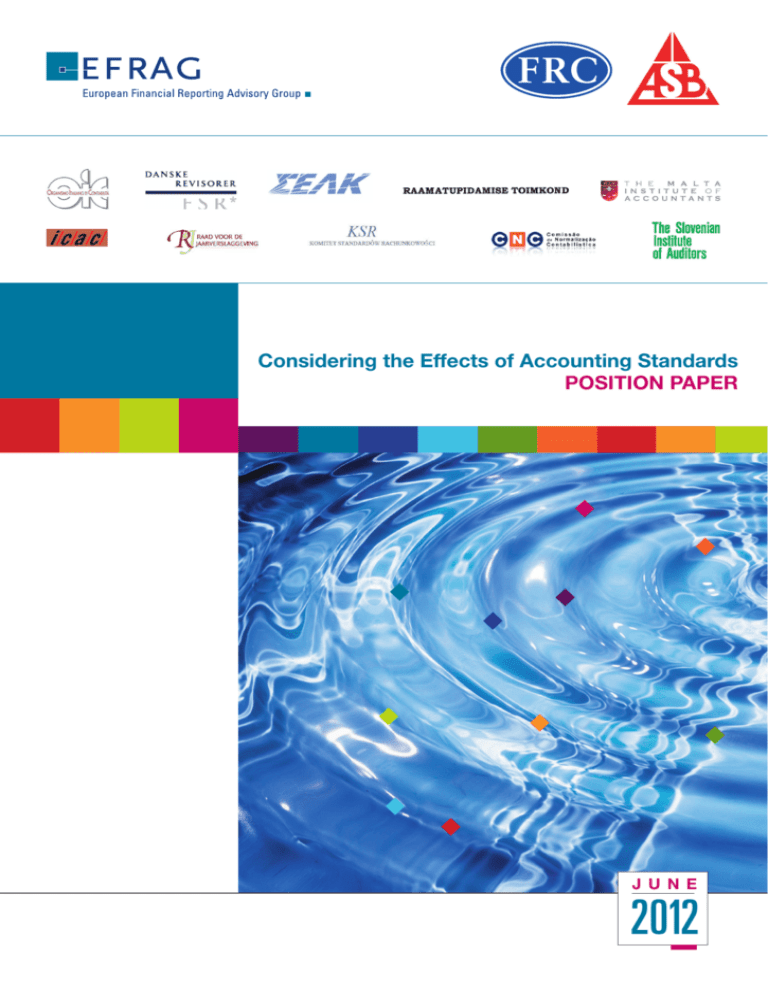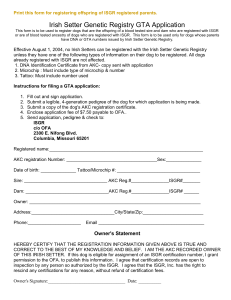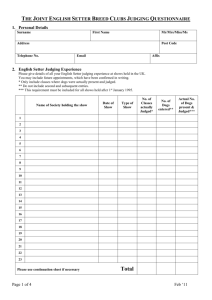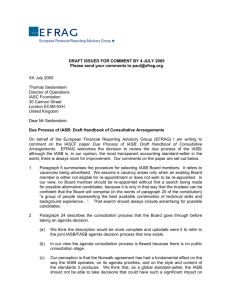Considering the Effects of Accounting Standards POSITION PAPER
advertisement

icac Considering the Effects of Accounting Standards POSITION PAPER J U N E 2012 © Financial Reporting Council and European Financial Reporting Advisory Group (2012) This position paper sets out the final positions reached by the Accounting Standards Board (ASB) and the European Financial Reporting Advisory Group (EFRAG) as the final step in the due process on their Discussion Paper “Considering the Effects of Accounting Standards”. The ASB and EFRAG have issued a Feedback Statement which is available at www.efrag.org. The paper is produced by the UK standard setter, the ASB, and EFRAG. Position Paper The main messages and recommendations in the position paper are also supported by the following standard setters in Europe: Considering the Effects of Accounting Standards 2 Cyprus, ICPAC - Institute of Certified Public Accountants of Cyprus Denmark, FSR - Danske Revisorer Estonia, EASB - Eesti Raamatupidamise Toimkond Italy, OIC - Organismo Italiano di Contabilità Malta, The Malta Institute of Accountants The Netherlands, RJ - Raad voor de Jaarverslaggeving Poland, Polish Accounting Standards Committee Portugal, CNC - Comissão de Normalização Contabilística Slovenia, Slovenski Institut za Revizijo Spain, ICAC - Instituto de Contabilidad y Auditoría de Cuentas These bodies welcome the positions reached in the Position Paper as a contribution to influencing the development of international financial reporting standards, although they may not necessarily agree with all detailed comments. Contents PURPOSE OF THIS REPORT 4 SECTION 1: Background 4 SECTION 2: The process of ‘effect analysis’ 5 SECTION 3: The concept of ‘effects’ 8 SECTION 4: Steps in performing effect analysis 11 SECTION 5: The practicalities of performing effect analysis 12 SECTION 6: Next steps 12 BIBLIOGRAPHY 13 ACKNOWLEDGEMENTS 15 Purpose of this report This paper is intended to reflect the final positions reached by the Accounting Standards Board (ASB) and the European Financial Reporting Advisory Group (EFRAG), following a period of consultation, with respect to the Discussion Paper ‘Considering the Effects of Accounting Standards’. A Feedback Statement analysing the comments received on the Discussion Paper is also issued by the ASB and EFRAG, and is available at www.efrag.org. This paper is aimed at assisting standard setters to implement (or further embed) effect analysis within their due process, in a proportionate way, with the objective of strengthening the standard setting process. Position Paper SECTION 1: BACKGROUND 1.1 The issue of whether accounting standard setters should take account of the effects, or consequences, of the standards they develop has been a subject of debate for decades, although without satisfactory resolution. The issue has become more prominent in recent years, and the term ‘effect analysis’ is gaining currency in standard setting. The main aims of integrating (or further embedding) ‘effect analysis’ into the standard setting due process are to strengthen that process and enhance its transparency, to increase the accountability and credibility of the standard setter, and thus to contribute positively to delivering improved financial reporting. 1.2 The requirement for an analysis of the anticipated effects of a new IFRS or a major amendment to an IFRS is included in the ‘Due Process Handbook for the IASB’1, as approved by the Trustees of the International Accounting Standards Committee Foundation2 in October 2008. The IASB Conceptual Framework3 should now also be updated to reflect the use of ‘effect analysis’. Considering the Effects of Accounting Standards 4 1 2 3 International Accounting Standards Committee Foundation (IASCF) (2008), Due Process Handbook for the IASB. The International Accounting Standards Committee Foundation (IASCF) has since been renamed as the International Financial Reporting Standards Foundation (IFRS Foundation). International Accounting Standards Board (IASB) (2010), Conceptual Framework for Financial Reporting 2010. SECTION 2: THE PROCESS OF ‘EFFECT ANALYSIS’ Definition of ‘effect analysis’: 2.1 Effect analysis is defined as ‘a process for considering the effects of accounting standards’. Effect analysis should be integrated (or further embedded) into the standard setting due process over the life-cycle of projects, starting from the agenda proposal stage through to post-implementation reviews. It is not merely a document or a single point-in-time event. 2.3 The main aims of effect analysis are to strengthen the standard setting process and enhance its transparency, to increase the accountability and credibility of the standard setter, and thus to contribute positively to delivering improved financial reporting. Standard setters may make informed decisions by applying effect analysis to assess effects against intended outcomes, consult with constituents and put together a comprehensive body of robust evidence to support those decisions, such that standard setters are thus readily able to demonstrate that their activities are contributing positively to delivering improved financial reporting. Responsibility for effect analysis: 2.4 The standard setter should have ultimate responsibility for considering the effects of accounting standards throughout the standard setting process, but other relevant bodies that are independent from the standard setter shall, where appropriate, be engaged in the process by means of partnering. The latter will potentially provide the standard setter with access to additional resources and technical expertise in performing specific studies to contribute to effect analysis. 2.5 The performance of effect analysis should be subject to an oversight process, in order to ensure its objectivity and enhance its credibility. Oversight should be exercised during the standard setting process. It should be kept independent, given that the standard setter, based on the outcome of effect analysis, may have to take a decision as to whether the project should be continued. However, the oversight process may be achieved within the existing governance structure, which should be sufficient to ensure that the standard setter maintains a reliable and effective internal quality control mechanism. This would mean that no additional arrangements need necessarily be put in place. 5 Considering the Effects of Accounting Standards 2.2 Position Paper The case for integrating (or further embedding) effect analysis into the standard setting due process: Frequency and timing of effect analysis: The issue of frequency: 2.6 Effects should be considered throughout the life-cycle of a project to introduce a new accounting standard or major amendment, but a summary of the key elements of the effect analysis should be made publicly available at specified points in time in that life-cycle. Those points in time should be determined so as to be consistent with the standard setter’s due process, and should be communicated. 2.7 More specifically: Position Paper a) Considering the Effects of Accounting Standards 6 During the agenda proposal and discussion paper stages, effect analysis is expected to be more high level, aiming to provide evidence both of the problem to be addressed, to make the agenda decision explicit, and of the implications (or effects) of the potential solution(s); b) Subsequently, at the exposure draft and the final standard stages, the standard setter should reassess the anticipated effects and intended outcomes of the proposals and consider all comments (and other input) received from constituents relating to the effects of the proposals; and c) During the post-implementation stage, an analysis of actual effects should be performed, to assess the extent to which the standard or amendment has met its intended outcomes in the context of the objective of the standard setter. Example: 1. Setting the agenda 2. Planning the project 3. Developing and publishing the discussion paper 4. Developing and publishing the exposure draft 5. Developing and publishing the standard 6. After the standard is issued The issue of timing and format: 2.8 Effect analysis should be made publicly available during the standard setting process, before finalising the relevant stage of that process, not just at the end when a standard or amendment is finalised. This will ensure that all communicated effects are taken into account when developing a standard or amendment, as well as at the end in the form of a postimplementation review. 2.9 The content of effect analysis should vary with different stages of the process, and the standard setter should provide evidence to justify: a) The problem to be addressed; The assessment, post-implementation, of whether the standard or amendment has been effective. 2.10 After effect analysis is first made publicly available, an analysis which is made public at subsequent stages may in practice be an update to the previous analysis undertaken, to reflect the latest information available. As an accounting standard or amendment is implemented, anticipated effects are reassessed based on more up-to-date information and evidence; actual effects, in terms of the experience of stakeholders, may not be consistent with anticipated effects. The standard setting process, including the effect analysis, should reflect this, by allowing stakeholders to assess what evidence has been gathered and how effects have been considered. The confidentiality of participant stakeholders should be safeguarded, so only overall findings should be made publicly available. Why publicly available? 2.11 Good governance demands that the standard setting process should be transparent. Improving the transparency of the standard setting process will not only complement the internal quality controls of the standard setter, but will also enhance the value of effect analysis by encouraging parties whose views are not represented to contribute to it. Proportionality in performing effect analysis: 2.12 Effect analysis should be undertaken for all new accounting standards and major amendments, but the analysis work should follow the principle of proportionality in terms of the degree of analysis work undertaken. Therefore, work should be adjusted to the scale of the anticipated (or intended) effects. 7 Considering the Effects of Accounting Standards c) Position Paper b) The implications of the solution proposed; and SECTION 3: THE CONCEPT OF ‘EFFECTS’ Definition of ‘effects’: ‘Effects’ are ‘consequences that flow, or are likely to flow, from an accounting standard’. 3.2 The effects of a new accounting standard or amendment should be characterised and considered against its intended outcomes, and in the context of the objective of the standard setter. The objective of the standard setter should be ‘to contribute positively to delivering improved financial reporting’. 3.3 The term ‘effects’ can be used to refer to both ‘anticipated effects’ and ‘actual effects’, depending on what stage an effect analysis is at – before, during or after implementation of the new accounting standard or amendment. Position Paper 3.1 Considering the Effects of Accounting Standards 8 Comparing the term ‘effects’ to the term ‘costs and benefits’; the issue of quantification: 3.4 The term ‘effects’, rather than the term ‘costs and benefits’, should be used to refer to the consequences of accounting standards4, in order to distinguish effect analysis from a quantified cost benefit analysis. 3.5 The term ‘costs and benefits’, particularly ‘costs’, is often associated with quantification, but this paper recognises that some ‘effects’ cannot be easily quantified, so quantifiable ‘costs and benefits’ are thus a subset of all ‘effects’ as considered by this paper. The distinction between ‘effects’ and ‘costs and benefits’ is also made because of the inherent difficulties relating to the consideration of macro-economic effects; in particular, an accounting standard or amendment can have opposing effects on different groups, or more than one directly measurable effect can exist. 3.6 Although it is difficult to measure effects arising from an accounting standard or amendment, quantification should not be entirely left out and in some situations it might be appropriate to perform a quantified cost benefit analysis. A quantified cost benefit analysis has a useful role to play where quantification of costs and benefits is practical and where it would offer further insight in understanding effects. 4 The IASB Conceptual Framework should be amended so that it uses the term ‘effects’, rather than the term ‘costs and benefits’, to refer to the consequences of accounting standards. 3.7 Accounting standards will potentially result in both micro-economic and macro-economic effects. However, the scope of the ‘effects’ to be considered, for the purposes of performing effect analysis, should include those effects that are within the remit of the standard setter – that is, the objective of improved financial reporting (see paragraph 3.2). More specifically, the standard setter should identify, analyse and take into account the effects that the new accounting standard or amendment is expected to have on investors and reporting entities. The standard setter should therefore focus on the intended micro-economic effects of the standard. 3.8 The standard setter should, nevertheless, endeavour to be aware of effects that go beyond the objective of the standard setter, such as macro-economic effects (e.g. financial stability impacts, the more efficient allocation of resources, redistributive effects within society, etc.). The standard setter should also make information about expected macro-economic effects publicly available, so that relevant bodies can take action. In some cases, it might also be appropriate for the standard setter to communicate an issue that has been identified directly to a relevant body. Position Paper The scope of the ‘effects’ to be considered: 3.9 Macro-economic effects identified during the standard setting process could affect the decisions of the standard setter without compromising the objective of improved financial reporting. For example, the standard setter may, where appropriate, take steps to minimise the impact of potential adverse macro-economic effects by selecting among alternatives that result in the same quality of financial reporting outcome. Such steps might include a decision for the standard setter to revise the effective date of an accounting standard or amendment in order to allow time for relevant monitoring bodies to react and coordinate appropriately, and for investors to adjust to the changes. Another step would be an amendment to transitional disclosures that assisted the capital markets in understanding the impact of a new accounting standard or amendment. Reconciling the ‘expectation gap’ to the scope of the ‘effects’: 3.10 The quality of accounting standards is dependent on the independence of the standard setter, so endeavouring to be aware of effects that go beyond the objective of the standard setter should not mean that a standard setter takes on a broader public policy role previously associated with other regulators and government bodies, but nor should they operate in isolation to the rest of financial regulation. Considering the Effects of Accounting Standards 9 3.11 There is perhaps a significant ‘expectation gap’ concerning what standard setters are able to do and what effects they are able or best placed to respond to, as highlighted by the arguably unwarranted criticism of standard setters following the emergence of the financial crisis. A standard setter can only be expected to respond to an effect that goes beyond the objective of the standard setter by discussing the effect with relevant parties so that those parties can take action if necessary (see paragraph 3.8), and by considering whether a modification to the proposed accounting standard or amendment, consistent with the standard setter’s objective, is appropriate (see paragraph 3.9). The standard setter is neither responsible for formally addressing such an effect for the purposes of performing effect analysis, nor expected to obtain confirmation from a regulator or government body that they will respond appropriately to such an effect. Position Paper ‘Incidence’, ‘nature’ and prioritisation of effects: 3.12 When considering the ‘incidence’ (who is affected) , ‘nature’ (how they are affected) and prioritisation (which effects get higher or lower weight) of effects, the standard setter should be transparent about whether and why they consider that the effects on one group should receive greater weight, less weight or equal weight to the effects on any other group. Considering the Effects of Accounting Standards 10 3.13 Prioritisation, although potentially useful (if not essential), may be difficult and could, if strictly applied, result in a rigid process. The standard setter, in conjunction with stakeholders, should develop a process for prioritising effects that is capable of being implemented in a flexible way. Flexibility should be assessed on an ongoing basis, and adjustments should be made as necessary to ensure that effect analysis does in fact strengthen the standard setting process. SECTION 4: STEPS IN PERFORMING EFFECT ANALYSIS 4.1 The following steps should underpin effect analysis: Step 1: Formulate the entire plan of effect analysis, explaining the intended outcomes at the agenda setting stage; Step 2: Encourage input on anticipated effects when due process documents are issued; Position Paper Step 3: Document a summary of inputs from stakeholders by collecting all evidence received, and make the document publicly available; and Step 4: Measure actual effects during the process of post-implementation reviews. 11 These steps are important in reinforcing the main aims of effect analysis. 1. Formulate entire plan, and explain intended outcomes 4. Measure actual effects during postimplementation review Gather evidence 2. Encourage input on anticipated effects 3. Summarise inputs for stakeholders and make publicity available Intended outcomes achieved Considering the Effects of Accounting Standards 4.2 Position Paper SECTION 5: THE PRACTICALITIES OF PERFORMING EFFECT ANALYSIS 5.1 It is too early to decide on the practical details of the process of effect analysis, before any experience is gained. This paper has therefore set out an outline process (objective and key steps), with a view to finalising the practical details at a later stage. 5.2 It is essential that the practicalities of performing effect analysis be kept simple, to ensure that it is implemented to serve the standard setting process and that it does not become a mechanistic means of satisfying a due process requirement. SECTION 6: NEXT STEPS 6.1 The positions expressed in this paper refer to effect analysis as part of a generic standardsetting due process, and are thus directed to all standard setters. However, this ‘next steps’ section mostly reflects how the proposals might shape, or have already impacted, the IASB standard-setting due process in particular. 6.2 The IASB should, where appropriate, form partnerships with accounting standard bodies, so as to be involved in the effect analysis process, in terms of gathering evidence of the effects of accounting standards and by playing an active part in the standard setting due process. This will ensure that they thus work with the IASB in contributing positively to delivering improved financial reporting. The IASB and its partners, that is the accounting standard bodies, should, where appropriate, rely on the input of academics or other relevant bodies when effect studies are being performed. EFRAG and the ASB are of the opinion that relevant procedures should be put in place to define the basis of collaboration, enabling partners to be consistent while relying on each other’s work. 6.3 The IASB, as an international standard setter, should initiate a procedure to encourage National Standard Setters and other institutions to: Considering the Effects of Accounting Standards 12 a) Share their knowledge and experience in the area of effect analysis, taking the proposals forward to the implementation stage; and b) Work together with National Standard Setters and other standard-setting bodies to design and test (possibly as an active IASB project) the methodology for effect analysis. 6.4 The IFRS Trustees have recommended that the IASB chair an international working group to develop an agreed methodology for effect analysis and field testing. EFRAG and the ASB support this recommendation. Bibliography Ball, Ian (2006) “Overview of Fair Value Measurement Requirements in IFRSs” (2006), United Nations Conference on Trade and Development Working Group of Experts on International Standards of Accounting and Reporting (October 2006). Corporate Reporting User Forum (CRUF) (2008), Letter of 5 June 2008, to Sir David Tweedie and Bob Hertz. Department for Business, Innovation and Skills (BIS) (2010), Impact Assessment Guidance. European Commission (2009), Comment letter (CL68) of 22 June 2009, to the International Accounting Standards Committee Foundation (IASCF) in response to the discussion document ‘Review of the Constitution – Identifying Issues for Part 2 of the Review’. Financial Accounting Standards Board (FASB) (2008), Original Pronouncements As Amended – Statement of Financial Accounting Concepts No. 2 – Qualitative Characteristics of Accounting Information. Financial Crisis Advisory Group (FCAG) (2009), Report of the Financial Crisis Advisory Group. Financial Reporting Council (FRC) and the European Financial Reporting Advisory Group (EFRAG) (2011) Considering the Effects of Accounting Standards, Discussion Paper. Gellein, Oscar S. (1978) “Neutrality has Consequences”, FASB Special Report – Benefits, Costs and Consequences of Financial Accounting Standards (November 1991). Government of Western Australia (1999), Guidelines for Managing Risk in the Western Australian Public Sector. International Accounting Standards Board (IASB) (2008), Business Combinations Phase II – Project summary, feedback and effects analysis. International Accounting Standards Board (IASB) (2010), Conceptual Framework for Financial Reporting 2010. International Accounting Standards Board (IASB) (2009), Project Summary and Feedback Statement – IFRS 9 Financial Instruments – Part 1: Classification and measurement. 13 Considering the Effects of Accounting Standards Financial Accounting Standards Advisory Council (1990) “Are Costs-Benefits Measurable?”, FASB Special Report – Benefits, Costs and Consequences of Financial Accounting Standards. Position Paper European Commission (2009), Impact Assessment Guidelines. International Accounting Standards Committee Foundation (IASCF) (2010), Constitution. International Accounting Standards Committee Foundation (IASCF) (2007), Press Release – Summary of the IASC Foundation Trustees meeting April 2007. International Accounting Standards Committee Foundation (IASCF) (2008), Due Process Handbook for the IASB. International Accounting Standards Committee Foundation (IASCF) (2010), Report of the IASC Foundation Trustees on Part 2 of their Constitution Review – Changes for Enhanced Public Accountability and Stakeholder Engagement. International Public Sector Accounting Standards Board (IPSASB) (2007), Preface to International Public Sector Accounting Standards. 14 National Audit Office (NAO) (2007), Evaluation of Regulatory Impact Assessments 2006-07. Considering the Effects of Accounting Standards Position Paper International Federation of Accountants (IFAC) (2010), A Public Interest Framework for the Accountancy Profession – Exposure Draft. Radaelli, Claudio M. and Meuwese, Anne C. M. (2008) “Better Regulation in Europe: Between Public Management and Regulatory Reform”, Public Administration (September 2009, Volume 87, Issue 3). Robertson, Craig (2008) “Impact Assessment in the European Union”, Eipascope (September 2008, Special Issue 2008/2). Schipper, Katherine (2009) “How Can We Measure the Costs and Benefits of Changes in Corporate Reporting Regulation?”, Information for Better Markets Conference (December 2009). Solomons, David (1978) “The Politicization of Accounting”, The Journal of Accountancy (November 1978, Volume 146, No. 5). Teixeira, Alan (2010), Agenda Paper for the Standards Advisory Council (SAC) Meeting of February 2010 – Effects Analysis. Tweedie, Sir David (2008) “Beancounters or Market Drivers? – The Role of the Reporting Accountant”, Institute of Chartered Accountants of Scotland (ICAS) Conference (September 2008). Wiener, Jonathan B. (2006) “Better Regulation in Europe”, Duke Law School Faculty Scholarship Series (October 2006). Zeff, Stephen A. (1978) “The Rise of “Economic Consequences””, The Journal of Accountancy (December 1978, Volume 146, No. 6). Ackowledgements Position Paper This paper has been prepared jointly by the staff of the UK standard setter, the Accounting Standards Board (ASB), and the staff of the European Financial Reporting Advisory Group (EFRAG), as part of Europe’s proactive work in financial reporting. It is a position paper to reflect the views of the ASB and EFRAG, as informed by a process of consultation, with respect to a discussion paper of the same title, the lead author of which was Grant Chatterton (a Project Director at the ASB), with significant contributions provided by Mario Abela (former Director of Research at EFRAG) and David Loweth (former Technical Director at the ASB). The contributors to the position paper are the same as for the discussion paper, but have also been extended by Michelle Sansom (Director of Accounting at the ASB), Magdalena Zogala (a former Project Manager at EFRAG) and Apostolena Theodosiou (a Project Manager at EFRAG). Considering the Effects of Accounting Standards 15




